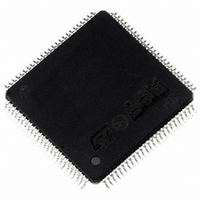ST92F150CV1TB STMicroelectronics, ST92F150CV1TB Datasheet - Page 343

ST92F150CV1TB
Manufacturer Part Number
ST92F150CV1TB
Description
MCU 8BIT 128K FLASH 100TQFP
Manufacturer
STMicroelectronics
Series
ST9r
Datasheet
1.ST92F150CV1TB.pdf
(429 pages)
Specifications of ST92F150CV1TB
Core Processor
ST9
Core Size
8/16-Bit
Speed
24MHz
Connectivity
CAN, EBI/EMI, I²C, LIN, SCI, SPI
Peripherals
DMA, LVD, POR, PWM, WDT
Number Of I /o
77
Program Memory Size
128KB (128K x 8)
Program Memory Type
FLASH
Eeprom Size
1K x 8
Ram Size
4K x 8
Voltage - Supply (vcc/vdd)
4.5 V ~ 5.5 V
Data Converters
A/D 16x10b
Oscillator Type
Internal
Operating Temperature
-40°C ~ 105°C
Package / Case
100-TQFP, 100-VQFP
Processor Series
ST92F15x
Core
ST9
Data Bus Width
8 bit, 16 bit
Data Ram Size
6 KB
Interface Type
CAN, I2C, SCI, SPI
Maximum Clock Frequency
24 MHz
Number Of Programmable I/os
80
Number Of Timers
5 x 16 bit
Operating Supply Voltage
4.5 V to 5.5 V
Maximum Operating Temperature
+ 105 C
Mounting Style
SMD/SMT
Development Tools By Supplier
ST92F150-EPB
Minimum Operating Temperature
- 40 C
On-chip Adc
16 bit x 10 bit
Lead Free Status / RoHS Status
Lead free / RoHS Compliant
Other names
497-4883
Available stocks
Company
Part Number
Manufacturer
Quantity
Price
Company:
Part Number:
ST92F150CV1TB
Manufacturer:
STMicroelectronics
Quantity:
10 000
- Current page: 343 of 429
- Download datasheet (8Mb)
CONTROLLER AREA NETWORK (Cont’d)
10.10.8 Register Description
10.10.8.1 Control and Status Registers
CAN MASTER CONTROL REGISTER (CMCR)
Reset Value: 0000 0010 (02h)
Bit 7 = TTCM Time Triggered Communication
Mode
- Read/Set/Clear
0: Time Triggered Communication mode disabled.
1: Time Triggered Communication mode enabled
Note: For more information on Time Triggered
Communication mode, please refer to
10.10.5.2 Time Triggered Communication
Bit 6 = ABOM Automatic Bus-Off Management
- Read/Set/Clear
This bit controls the behaviour of the CAN hard-
ware on leaving the Bus-Off state.
0: The Bus-Off state is left on software request,
1: The Bus-Off state is left automatically by hard-
For detailed information on the Bus-Off state
please refer to
ment.
Bit 5 = AWUM Automatic Wake-Up Mode
- Read/Set/Clear
This bit controls the behaviour of the CAN hard-
ware on message reception during sleep mode.
0: The sleep mode is left on software request by
1: The sleep mode is left automatically by hard-
Bit 4 = NART No Automatic Retransmission
0: The CAN hardware will automatically retransmit
TTCM ABOM AWUM NART RFLM TXFP SLEEP INRQ
once 128 x 11 recessive bits have been moni-
tored and the software has first set and cleared
the INRQ bit of the CMCR register.
ware once 128 x 11 recessive bits have been
monitored.
clearing the SLEEP bit of the CMCR register.
ware on CAN message detection. The SLEEP
bit of the CMCR register and the SLAK bit of the
CMSR register are cleared by hardware.
- Read/Set/Clear
the message until it has been successfully
transmitted according to the CAN standard.
7
Section 10.10.5.6 Error Manage-
Section
Mode.
0
CONTROLLER AREA NETWORK (bxCAN)
1: A message will be transmitted only once, inde-
Bit 3 = RFLM Receive FIFO Locked Mode
- Read/Set/Clear
0: Receive FIFO not locked on overrun. Once a re-
1: Receive FIFO locked against overrun. Once a
Bit 2 = TXFP Transmit FIFO Priority
- Read/Set/Clear
This bit controls the transmission order when sev-
eral mailboxes are pending at the same time.
0: Priority driven by the identifier of the message
1: Priority driven by the request order (chronologi-
Bit 1 = SLEEP Sleep Mode Request
- Read/Set/Clear
This bit is set by software to request the CAN hard-
ware to enter the sleep mode. Sleep mode will be
entered as soon as the current CAN activity (trans-
mission or reception of a CAN frame) has been
completed.
This bit is cleared by software to exit sleep mode.
This bit is cleared by hardware when the AWUM
bit is set and a SOF bit is detected on the CAN Rx
signal.
Bit 0 = INRQ Initialization Request
- Read/Set/Clear
The software clears this bit to switch the hardware
into normal mode. Once 11 consecutive recessive
bits have been monitored on the Rx signal the
CAN hardware is synchronized and ready for
transmission and reception. Hardware signals this
event by clearing the INAK bit if the CMSR regis-
ter.
Software sets this bit to request the CAN hardware
to enter initialization mode. Once software has set
the INRQ bit, the CAN hardware waits until the
current CAN activity (transmission or reception) is
completed before entering the initialization mode.
Hardware signals this event by setting the INAK bit
in the CMSR register.
pendently of the transmission result (successful,
error or arbitration lost).
ceive FIFO is full the next incoming message
will overwrite the previous one.
receive FIFO is full the next incoming message
will be discarded.
cally)
343/429
9
Related parts for ST92F150CV1TB
Image
Part Number
Description
Manufacturer
Datasheet
Request
R

Part Number:
Description:
BOARD PROGRAM FOR ST92F150 MCU
Manufacturer:
STMicroelectronics
Datasheet:

Part Number:
Description:
BOARD EVALUATION FOR ST9 SERIES
Manufacturer:
STMicroelectronics
Datasheet:

Part Number:
Description:
BOARD EMULATOR FOR ST9 SERIES
Manufacturer:
STMicroelectronics
Datasheet:

Part Number:
Description:
MCU, MPU & DSP Development Tools ST9 Dedication Board
Manufacturer:
STMicroelectronics
Datasheet:

Part Number:
Description:
STMicroelectronics [RIPPLE-CARRY BINARY COUNTER/DIVIDERS]
Manufacturer:
STMicroelectronics
Datasheet:

Part Number:
Description:
STMicroelectronics [LIQUID-CRYSTAL DISPLAY DRIVERS]
Manufacturer:
STMicroelectronics
Datasheet:

Part Number:
Description:
BOARD EVAL FOR MEMS SENSORS
Manufacturer:
STMicroelectronics
Datasheet:

Part Number:
Description:
NPN TRANSISTOR POWER MODULE
Manufacturer:
STMicroelectronics
Datasheet:

Part Number:
Description:
TURBOSWITCH ULTRA-FAST HIGH VOLTAGE DIODE
Manufacturer:
STMicroelectronics
Datasheet:

Part Number:
Description:
Manufacturer:
STMicroelectronics
Datasheet:

Part Number:
Description:
DIODE / SCR MODULE
Manufacturer:
STMicroelectronics
Datasheet:

Part Number:
Description:
DIODE / SCR MODULE
Manufacturer:
STMicroelectronics
Datasheet:











